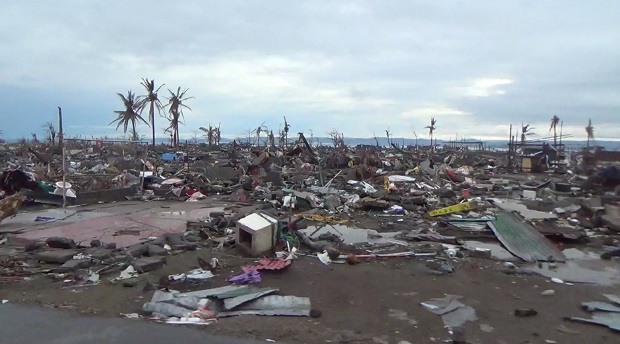16 PH cities not ready for climate change challenge, says study

Sixteen major cities in the country including Tacloban, which was flattened by Supertyphoon Yolanda in November 2013, are not ready for the effects of climate change, according to a study by the World Wildlife Fund and the BPI Foundation. Photo by Ryan Leagogo/INQUIRER.net FILE PHOTO
DUMAGUETE CITY, Philippines—Sixteen major cities in the country are not ready for the effects of climate change.
A study by the World Wildlife Fund (WWF) and the BPI Foundation found that the disaster preparedness of local governments, businesses and residents is more reactive than proactive.
The results of the study were presented in a forum here by Silliman University and the Oscar M. Lopez Center for Climate Change Adaptation and Disaster Risk Management Foundation Inc.
Conducted from 2011 to 2014, the Business Risk Assessment and the Management of Climate Impact covered Laoag, Baguio, Dagupan, Santiago, Angeles, Batangas, Naga and Puerto Princesa in Luzon; Cebu, Iloilo and Tacloban in the Visayas; and Cagayan de Oro, Butuan, Davao, General Santos and Zamboanga in Mindanao.
Jose Maria Lorenzo Tan, vice chair and chief executive officer of the WWF National Advisory Council, said the study focused on the cities because by midcentury, 60 to 70 percent of Filipinos would be living in urban areas.
Article continues after this advertisementThe study measured and analyzed how the largest Philippine cities could prepare for the escalating effects of climate change, confirming that things would get worse before they get better.
Article continues after this advertisement“Climate change will aggravate matters. All trends point to the likelihood of accelerated extreme weather events, emerging in a dynamic and nonlinear manner, with site-specific manifestations, spawning shifts in population density, and, therefore, in the consumption of natural capital,” Tan said.
Eleven of the 16 cities were likely to experience retreating coastline and increasing salinity of deltas due to rising sea levels as a result of thermal expansion, according to the study.
But none of the cities by the sea have retrofitted their seaports, coastal airports, major arteries, and commercial and residential developments to cope with rising sea levels.
The study noted an increasing volume of rainfall in 13 of the assessed cities.
Temperature data over the past 60 years showed an ever-increasing skew toward heightened warming, the study said.
Warmest year
Last year was the Earth’s warmest year since 1880. Except for El Niño in 1998, the 10 warmest years on record have occurred since 2000.
Unfortunately, increased warming would spawn extreme weather, according to the study.
A 2005 study by Webster pointed to a higher percent of Category 4 and 5 storms worldwide.
The WWF project looked at more current data on typhoons in the northwest Pacific Ocean, validating the 2005 Webster study and showing an increase in the number of typhoons with maximum sustainable winds in excess of 185 kilometers per hour.
“There is little doubt that more powerful storms will be part of our future,” the study said.
But even if the entire planet halts carbon emissions that cause global warming, Tan said it would take thousands of years for the climate to calm down.
Urgent challenge
While reducing carbon emissions may be a key solution, managing the risks poised by climate change is “clearly the more urgent challenge” for the Philippines, he said.
He urged local governments to update their comprehensive land use plans, to look at the future through a climate lens, to factor-in the likelihood of in-migration and to involve the private sector in their solutions.
“Diversification of development will diffuse climate risks. It will also spread out the impact of the human footprint,” Tan said.
“Disintegrated initiatives that do not account for frontline reality will be wasteful, inefficient and will slow down meaningful interventions,” he added.
RELATED STORIES
The language of climate change